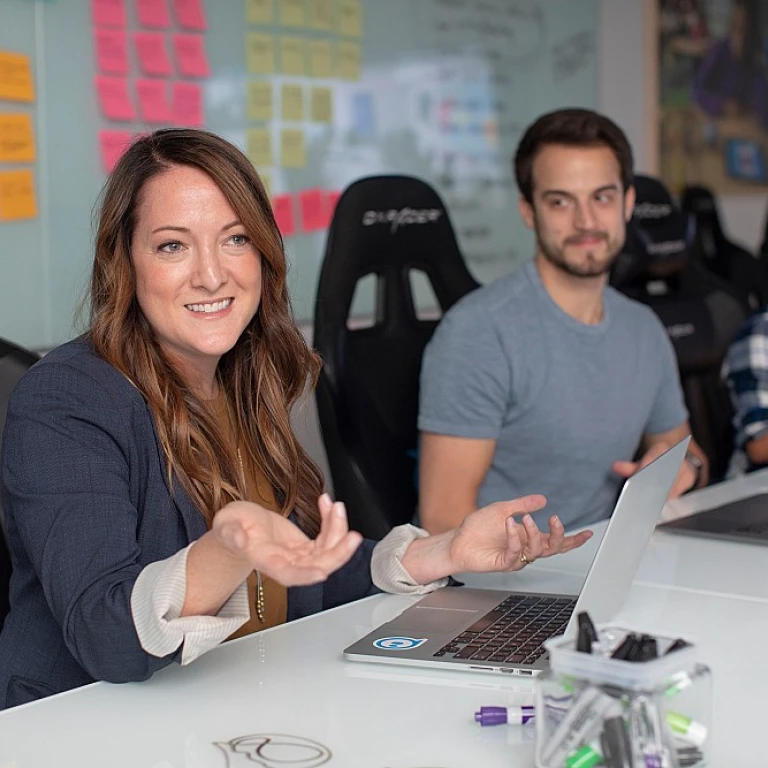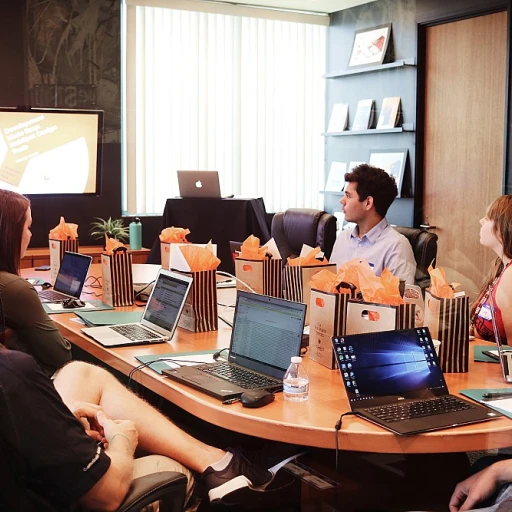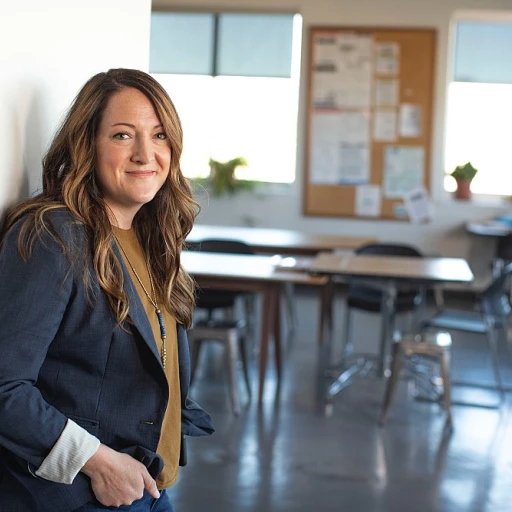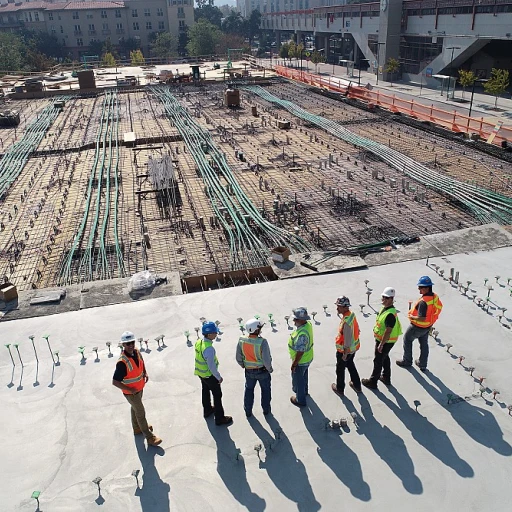
Understanding the Role of a Collaboration Table
The Cornerstone of Collaboration
A collaboration table serves as the cornerstone for teamwork, providing the necessary foundation for seamless interaction and idea exchange among team members. Rooted in both academia and the corporate world, it embodies the shift towards cooperative learning and working environments.
These tables, whether rectangular or round, are meticulously designed to facilitate group activities and discussions. The typical furniture setup might include soft seating or modular configurations like nesting tables, adjustable height options, and conference settings to cater to various needs.
The architecture of a collaboration table is pivotal; it's the base upon which successful engagements are fostered. The choice of material—ranging from wood to more contemporary designs—greatly influences the ambiance. Additionally, customization options, such as height adjustability and integration with connectivity technologies, further enhance their functionality.
In practice, supporting products like activity tables and certified BIFMA tables contribute to an effective collaborative atmosphere. The use of such specific designs, offered by notable brands like Herman Miller and Marco Group, ensures that these tables not only meet design standards but also align with workplace ergonomics.
Adopting a collaboration table as part of a training or office setup isn't merely about aesthetics; it's an intentional move towards creating an environment conducive to collaborative work. This setup offers more than just a place to meet—it's where ideas mix, innovate, and grow.
The Importance of Reskilling in Today's Workforce
The Critical Need for Skill Refreshers
In today's rapidly evolving job market, the significance of reskilling cannot be overstated. Organizations are increasingly recognizing the challenge of adapting their workforce, often opting for dynamic solutions like collaboration tables to foster learning environments. A collaborative setting, such as a round conference table or activity table, encourages interaction and active participation, which are key components for effective skill development.
With the rise of automation and technological advancements, professionals across various industries face the need to update their skills continuously. This shift is not limited to high-tech sectors but extends to academia, small businesses, and even the furniture industry, where even the design of products like modular soft seating and height-adjustable tables reflects evolving functionalities.
Creating Inclusive Learning Spaces
The use of collaboration tables in reskilling environments is a tangible step towards embracing change. These tables act as a base for seating arrangements that facilitate peer-to-peer learning and are ideal for group activities. Furniture options like nesting tables or Herman Miller's certified BIFMA tables provide versatile setups that adapt to diverse training needs. Such setups encourage employees to engage in collaborative training sessions with ease, augmenting the overall learning experience.
Furthermore, the integration of these tables into office spaces signifies a shift from traditional, rigid training methods to more flexible, inclusive practices. A carefully curated space with adjustable-height activity tables and soft seating enables a seamless transition between different training modules, accommodating various learning styles.
Staying Relevant in the Workforce
Emphasizing reskilling through such innovative approaches ensures that both individuals and companies remain competitive. As employers increasingly understand the value of investing in their workforce, the demand for versatile training spaces and collaborative products is on the rise. For those aiming to stay ahead in their careers, engaging with top HR podcasts can provide additional insights and guidance on the latest trends in skill development.
Facilitating Communication and Idea Sharing
Boosting Interaction and Encouraging Idea Exchange
The power of communication in any office or academic setting cannot be understated. Effective collaboration furniture, such as a thoughtfully designed collaboration table, acts as a powerful catalyst for idea sharing and engagement. Bringing individuals together, whether through modular soft seating or a strategic arrangement of activity tables, enhances the dynamic among team members. A collaboration table isn't just a piece of office decor or an adjustable height training table. It's a pivotal element that sets the stage for vibrant interplay, facilitating the flow of ideas much like a cafe table setting does. This soft seating arrangement can be compared to the dynamic environment of a small business round table meeting, fostering open dialogue and the sharing of perspectives. In collaborative settings, having a height-adjustable round table series can adapt to the requirements of different activities and participants, be it a conference table chat or a brainstorming session seated around office tables. The base and top materials, be they wood or something more innovative like white nesting table designs, ensure the adaptability and durability needed in high-energy environments. Productive collaboration often depends on the right mix of tangible environment and the intangible drive to ideate. As schedules grow busier, collaboration training must be flexible. Incorporating flexible solutions like Herman Miller's series round tables or certified BIFMA products means having bases and tops that cater to the specific conversation or activity at hand. Our evolving work environment demands teamwork activities that mirror the setup of a cafe office, blending the relaxed atmosphere of cafe tables with the functionality of the office. As collaboration tables evolve within these creative spaces, the potential for exchange is only set to increase, empowering teams to thrive. As the need for reskilling rises, be sure to explore opportunities like collaborative training and flexible career opportunities in Toledo, Ohio. The integration of furniture like collaboration tables with adjustable heights can create a fertile ground for interaction and growth, forming the bedrock of today's workforce development.Integrating Technology for Effective Reskilling
Integrating Modern Technology in Collaborative Reskilling Efforts
Incorporating technology into collaborative reskilling initiatives requires thoughtful integration to not only enhance learning outcomes but also foster a more dynamic learning environment. Utilizing adjustable height tables in training environments allows for seamless transitions between distinct activities, catering to the diverse needs of participants and trainers alike. This flexibility is crucial in today's fast-paced educational settings.
For optimal effectiveness, collaboration tables equipped with technology-friendly features, such as built-in charging ports and wireless connectivity, greatly enhance the learning experience. These features enable a hands-on approach to reskilling, allowing participants to immediately apply what they learn in a real-world context.
Moreover, the integration of virtual platforms alongside tangible tools such as modular soft seating or activity tables can create a hybrid learning hub. Such setups not only facilitate collaborative work but also mimic modern office environments, preparing participants for a seamless transition into new roles.
Modern collaboration furniture from reputable vendors like Herman Miller or Marco Group enhances this setup, offering both aesthetic appeal and functional versatility. A round table arrangement, for instance, encourages open discussion, eliminating any hierarchical barriers often found at traditional conference tables.
To ensure a successful implementation, it's vital to opt for certified BIFMA products. These not only meet rigorous safety and performance standards but also ensure sustainability, reinforcing an organization's commitment to corporate responsibility.
Case Studies: Success Stories of Reskilling with Collaboration Tables
Real-World Examples of Reskilling Success
In the ever-evolving landscape of today's workforce, reskilling has become a pivotal strategy for both individuals and organizations. The integration of collaboration tables into reskilling programs has proven to be a game-changer, facilitating enhanced communication and idea sharing. Here, we explore some real-world examples where collaboration tables have played a crucial role in successful reskilling initiatives.
Tech Industry Transformation
In the tech industry, where rapid changes are the norm, companies have turned to collaboration tables to foster a culture of continuous learning. A leading software company revamped its office space with adjustable height collaboration tables and modular soft seating. This setup encouraged employees to engage in collaborative training sessions, where they could easily share code and brainstorm solutions. The result was a more agile team, capable of adapting to new technologies and methodologies swiftly.
Educational Institutions Embrace Change
Academia has also embraced the concept of collaboration tables to enhance learning environments. A prominent university introduced activity tables and cafe tables in their training rooms. These tables, with their round tops and adjustable heights, created a dynamic learning space. Students and faculty engaged in collaborative activities, leading to a more interactive and engaging educational experience. This approach not only improved academic performance but also prepared students for the collaborative nature of modern workplaces.
Small Business Innovation
Small businesses, often constrained by resources, have found innovative ways to reskill their workforce using collaboration tables. A local cafe, for instance, utilized a series of round tables to conduct regular training sessions for their staff. The cafe's owner noted that the informal setting of the cafe tables encouraged open communication and idea exchange, leading to improved customer service and increased sales.
Corporate Success with Herman Miller Furniture
Large corporations have also seen the benefits of incorporating collaboration tables into their reskilling efforts. A multinational company invested in Herman Miller furniture, including conference tables and nesting tables, to create a flexible training environment. This investment paid off as employees reported higher satisfaction levels and improved productivity, attributing these gains to the collaborative nature of their training sessions.
These case studies highlight the transformative impact of collaboration tables in reskilling initiatives. By creating environments that promote interaction and idea sharing, organizations can effectively prepare their workforce for the challenges of the modern world.
Best Practices for Implementing a Collaboration Table
Creating the Optimal Environment for Collaboration
Implementing a collaboration table in your workplace involves more than just picking out a piece of furniture. Key considerations lie in maximizing its effectiveness for your team’s reskilling efforts. Here’s how you can set up a conducive atmosphere:- Assess Your Team’s Needs: Understand the specific reskilling requirements of your team. This might include the types of software they will use, the collaborative adjustments needed, or even the physical space constraints.
- Choose the Right Table: Whether you need a training table or a set of nesting tables for modular setups, selecting furniture that matches your workflow is crucial. Consider the adjustable height feature for flexibility and compare products like those from Marco Group or Herman Miller for quality options.
- Select Appropriate Seating: For maximum comfort and productivity, softe seating options should complement your setup. This can boost engagement in training activities and facilitate better communication.
- Create a Versatile Layout: An adaptable environment can make all the difference. Incorporate series round tables or cafe tables for casual meetings, and small conference tables for more formal discussions.
- Integrate Technological Tools: As technology is pivotal in reskilling, ensure the chosen table design accommodates cabling and tech devices. Linking your collaborative activities with tech will enhance training outcomes.













